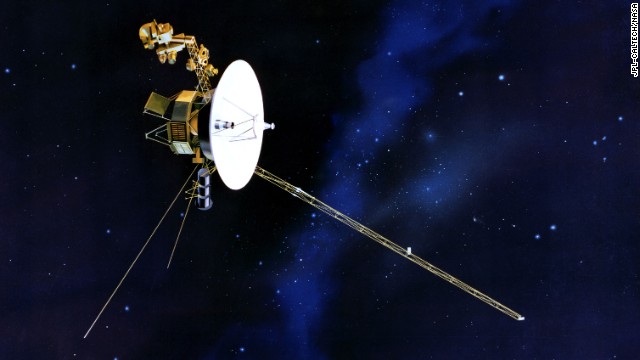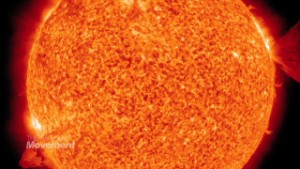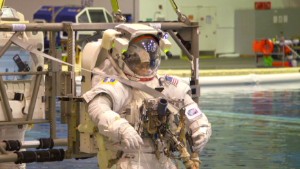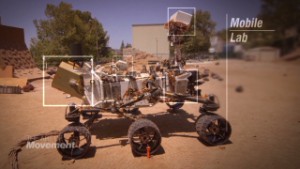STORY HIGHLIGHTS
- Launched in 1977, Voyager 1 was part of a twin-spacecraft mission on a multi-planet tour
- A rare planetary alignment let the mission travel past Jupiter, Saturn, Uranus, Neptune
- The two Voyagers have provided unparalleled insight into our solar system
- NASA announced Voyager 1 had left heliosphere last year, but some dispute that
The Art of Movement
is a monthly show that highlights the most significant innovations in
science and technology that are helping shape our modern world.
(CNN) -- Hurtling across the Milky Way like an eternal explorer -- the Voyager 1 spacecraft continues to nonchalantly reveal the mysteries of the solar system to a captivated Earthbound audience.
Active volcanoes, methane rain, icy geysers and intricate details about Saturn's rings
-- the list of revelations attributed to the mission reads like
fantastical sci-fi novel but it has revolutionized planetary astronomy.
Thirty-seven years after it launched, Voyager 1 is still out in the vast expanse of space, periodically relaying new data back home. But in 2013, NASA made the groundbreaking announcement that Voyager 1 had left the heliosphere
-- a magnetic boundary "bubble," if you will, which scientists use to
explain the separation of our solar system from the rest of the galaxy.
"That means Voyager has
traveled outside the bubble of our sun," explains Voyager project
manager Suzy Dodd. "The data Voyager 1 sends us now is data from other
stars and from super nova eruptions and the remnant of stars that have
exploded over the course of history."
It's an incredible
achievement for a probe built for an initial five-year mission. But now,
not for the first time since the extraordinary statement, doubts have
been cast on whether the craft has actually made the historic crossing.

While measurements
allowed NASA to feel confident enough to confirm Voyager 1 had entered
interstellar space, two University of Michigan scientists who have
worked on the Voyager missions remain skeptical.
 Reliving the moon landing
Reliving the moon landing
 Solar flares caught on camera
Solar flares caught on camera
 Zero gravity training with NASA
Zero gravity training with NASA
 Maneuvering NASA's Curiosity rover
Maneuvering NASA's Curiosity rover
"This controversy will
continue until it is resolved by measurements," said George Gloeckler, a
University of Michigan professor of atmospheric, oceanic and space
sciences, and lead author of a new study, in an American Geophysical
Union press release.
To that end, Gloeckler
and fellow University of Michigan professor and study co-author Len
Fisk, predict that when Voyager does cross the threshold into
interstellar space, the probe will identify a reversal in the magnetic
field, which will be relayed back to scientists on Earth, conclusively
determining the spacecraft's location. They expect this magnetic field
shift to occur in the next two years, and if it doesn't, this would
confirm that Voyager 1 has already left the heliosphere.
But while we may not
know the exact location of Voyager 1, we do know that it's one of the
most successful spacecraft of all time.
'The little spacecraft that could'
Launched individually in the summer of 1977, Voyager was a twin-spacecraft primary mission developed by NASA to explore Jupiter and Saturn and their larger moons.
Following successful
completion of the Voyager mission's primary objectives, a rare planetary
alignment offered up remarkable opportunities for the two craft to
continue space exploration.
"Voyager took advantage
of alignment of the outer planets, which are Jupiter, Saturn, Uranus and
Neptune, to be able to go by all four of those planets in a 12-year
period. That alignment of planets only happens every 176 years," says
Dodd -- who has described Voyager 1 as "the little spacecraft that
could."
"The data Voyager 1 sends us now is data from other stars ... that have exploded over the course of history.
Voyager project manager Suzy Dodd
Voyager project manager Suzy Dodd
So in 1980 the Voyager mission was officially extended and renamed the Interstellar mission. The probes were now participating in an exploratory odyssey to the farthest reaches of the heliosphere ... and beyond.
Through remote-control
reprogramming -- a technological advancement unavailable at launch --
using Saturn's gravitational field, the Voyager 1 probe was fired like a
slingshot on a trajectory that would take it onwards into interstellar
space.
Meanwhile Voyager 2 was
redirected onto a new flight path, taking in the sights of Neptune and
Uranus, before it will eventually follow its counterpart out of the
heliosphere. To this day, it remains the only man-made object to have
visited Neptune and Uranus.
Not bad for vintage
technology that has just 70 kilobytes of memory on board; a 16 gigabyte
iPhone 5 has more than 240,000 times that amount.
Voyager 1 is now so far
from Earth that commands take more than 17 hours to reach it. But it
will be a little while before the spacecraft will encounter any more
planets.
"It is going to take us
40,000 years to come within three light years of the next nearest sun or
the next nearest star," says Dodd. "And that is a long, long time."

No comments:
Post a Comment